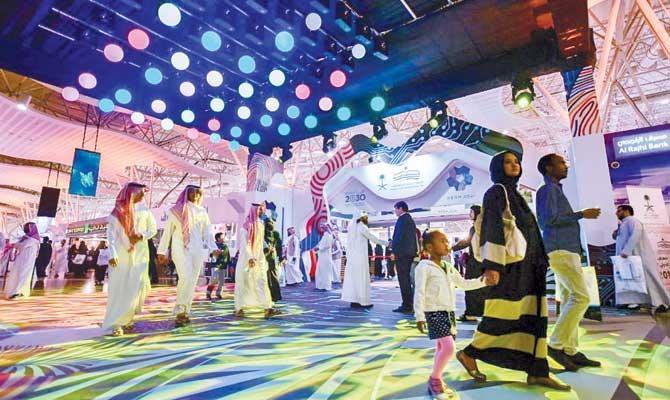
Saudi Arabia’s megaprojects in spotlight at Riyadh International Book Fair
Visitors arriving at the Riyadh International Book Fair 2019, one of the region’s largest cultural events, enter through four main gates bearing the names of the Saudi Vision 2030’s megaprojects: Neom, Qiddiyah, Red Sea and Amaala. The aim is to introduce visitors to the Kingdom’s hopes, ambitions and future plans.
The first gate leads visitors to virtual photos of the Qiddiya project. This is a cultural, sports and recreational project in Al-Qidiyya city, southwest of Riyadh. The city was named after the Aba Al-Qid road (Camel Trail) that used to connect Al-Yamama to Hijaz.
The second gate, Neom, contained a large electronic chip, alternative energy-based lighting and photos of Neom future projects. Neom is based in three countries, Saudi Arabia, Jordan and Egypt, with a half-a-trillion-dollar investment and the support of the Public Investment Fund of Saudi Arabia.
Located in the northwest of the Kingdom, the project will stretch across the Egyptian and Jordanian borders. Neom aims to transform the Kingdom into an international pioneering example, through the introduction of value chains of industry and technology.
The origin of the name is a combination of the word “neo” — Latin for “new,” and the first letter “m” of the Arabic word “mustaqbal” which translates as “future.”
The Red Sea gate shows a virtual image of the Kingdom’s coast in the future. This is a touristic project that includes more than 50 islands located between the cities of Umluj and Al-Wajh. It covers a number of the Red Sea’s untouched islands, as well as the archaeological site of Madain Saleh and a nature reserve containing regional flora and fauna.
The Amaala project displayed at the fourth gate of the fair will offer an ultra-luxurious touristic experience focused upon wellness, healthy living and meditation, thanks to the site’s moderate climate. The project will be within the Mohammed bin Salman Natural Reserve in the northwest of the Kingdom, to the south of the Neom project.
Cultural heritage
Saudi cultural heritage, that has been officially recognized by the UN Educational, Scientific and Cultural Organization, is being celebrated with an exhibition at the fair. The display includes official UNESCO certificates awarded in recognition of the importance of Arab and Saudi culture and traditions such as the mizmar flute; Arabic coffee; the majlis; Al-Qatt Al-Asiri interior wall decorations; the Ardeh, the Saudi folkloric dance; and falconry.
Falconry has been on UNESCOS’s List of the Intangible Cultural Heritage of Humanity since 2012. The Ardeh, which was added in 2016, combines poetry, swordplay and drums, and is one of the most prominent performing arts in the Kingdom.
Arabic coffee, added in 2015, has been an important part of life in the region for hundreds of years and has its own deeply rooted customs and traditions. Majlis, a gathering place for social events, discussions of social issues and honoring guests, was also added in 2015.
The mizmar flute, registered by UNESCO in 2016, is one of the best-known musical arts in the Hijaz region. Al-Qatt Al-Asiri was the most recent Saudi addition to the list, in 2017. It is a traditional form of art that women use to decorate the interior walls of Asiri homes.



























